Dell U2412M - 16:10 IPS without Breaking the Bank
by Chris Heinonen on February 28, 2012 9:00 AM ESTDell U2412M Color Quality
With that long write-up out of the way, you might expect that there was something in particular to the U2412M that led me to explain our testing and results. There initially was but it actually proved to be a software issue; still, I thought the explanation on the previous page would be useful for everyone. For our uncalibrated measurements, I used the profile included on the CD, set the brightness to 200 nits, and then measured using the i1Pro meter.
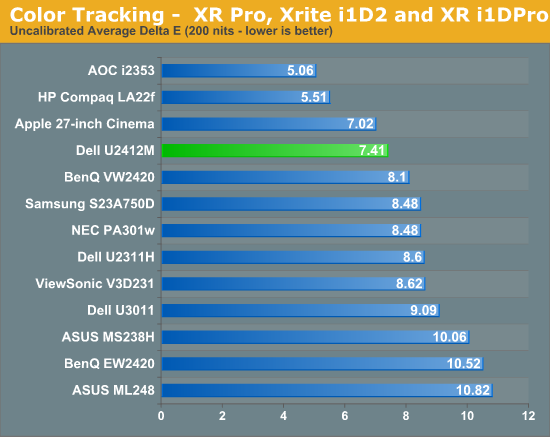
Here we see a score over 7, which is about what we expect to see on a monitor straight out of the box. Comparing this to previous displays isn’t easy to do as most of those used the i1Display2, which isn’t nearly as accurate as the i1Pro is. Of course, all displays do better once calibrated, so I kept the brightness target at 200 nits, with a white point target of D65, gamma of 2.2, and minimum black target.
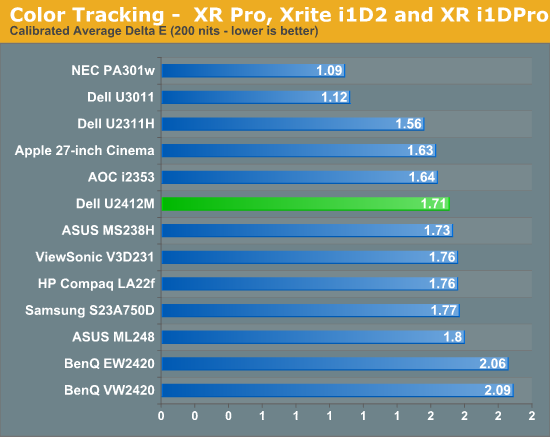
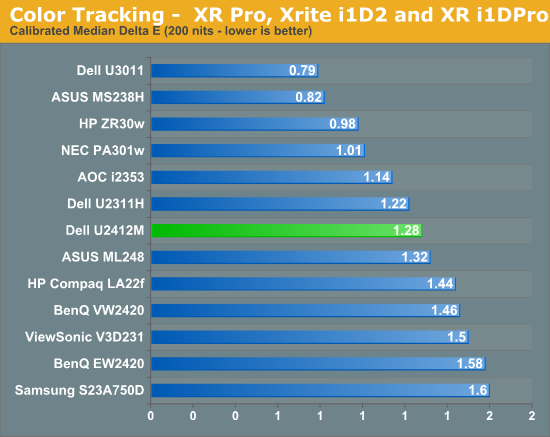
The errors for the Dell look very similar to what we have seen on other monitors. The color gamut is not AdobeRGB, so some of the patches are outside of the range for the display and can’t be rendered correctly. This leads to the spikes in the chart for blue samples and the higher average dE. We included the median dE number so you can see that the value drops quite a bit if we look at that. Everything other than blue is pretty good, and the grayscale is right around 1. So this is nice overall, though not perfectly accurate due to the color gamut and possibly due to the 6-bit panel. Now we will profile again to see if the results are similar with a target of 100 nits instead of 200 nits.
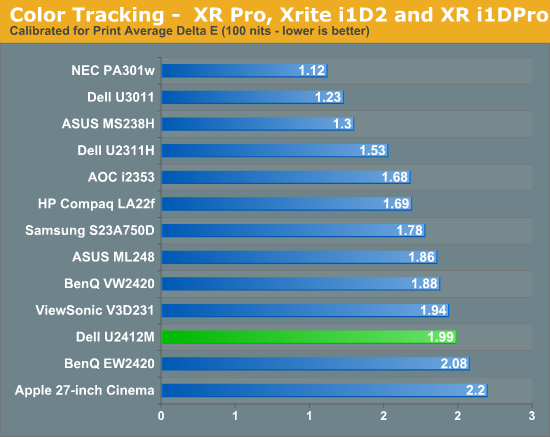
The error seems to rise a bit here, most notably in the grayscale that you would want to keep very neutral for print work. Most colors stay below 3.0 in their error (which is considered the threshold of being visible to the naked eye in motion) but again the blues are past that and errors would be visible to someone that was looking. For serious print work, you probably need to look for something that can use the full AdobeRGB gamut.



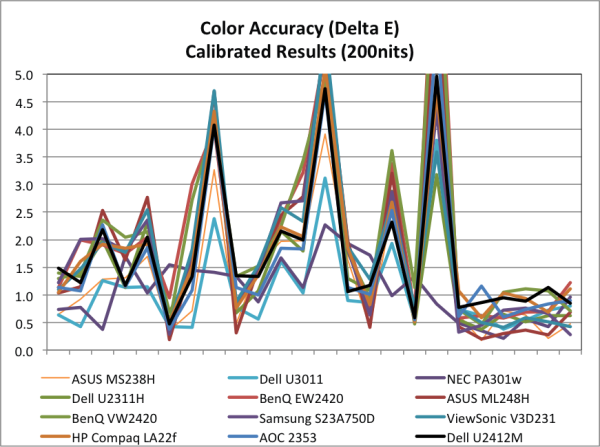
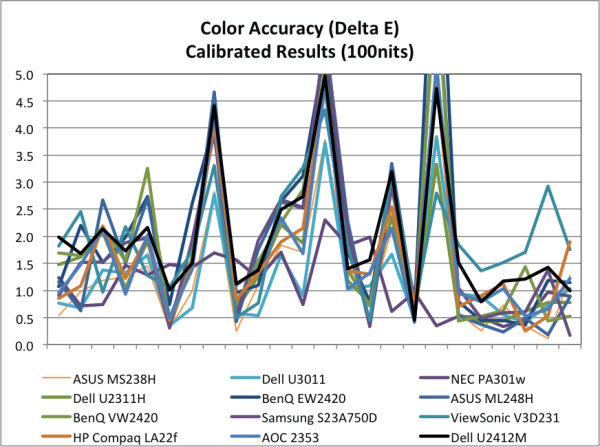








143 Comments
View All Comments
DarkUltra - Tuesday, February 28, 2012 - link
- I know that as soon as I check the comments there will be a thread with the same theme: “I don’t care about 1080p monitors, I only want 16:10 aspect ratios!”And don't forget the 120hz thread! You really should mention 120hz in your reviews, it should affect the manufacturers and readers so we can move to this new standard. Even as slow as 8ms gtg response time will benefit as 1000/120=8,33. The pixels change sooner, too. But lower response time will make things look sharper when they are moved around.
DarkUltra - Tuesday, February 28, 2012 - link
120Hz will drastically improve your desktop and gaming experience. Here is a few reviews and testimonies.- Wonder in amazement as the 120Hz display produces an easily observable higher fluidity in the animation.
techreport.com/articles.x/21516
- The ASUS VG236H was my first exposure to 120Hz refresh displays that aren’t CRTs, and the difference is about as subtle as a dump truck driving through your living room. www.anandtech.com/show/3842/asus-vg236h- review-our-first-look-at-120hz
- Doing precise image editing, as another example, is an area where faster display processing times are desirable. www.anandtech.com/show/2787
- 120hz lcd Smoother motion and the lack of RTC artifacts leave a highly positive impression, making you unwilling to return to 60Hz. www.xbitlabs.com/articles/monitors/display/ samsung-sm2233rz_5.html
- I ran Fraps and found using the display’s 120hz mode that once the framerates were up above 80 there is an amazing solidity and 3d- like quality to the gameplay. Once the framerate hits 100+ – well, the effect has to be experienced to understand it. hardforum.com/showthread.php? t=1486357&page=4
- I saw a 120hz monitor at my local MicroCenter and was totally amazed by how smooth the mouse moved on the desktop, makes my 60hz monitor looks absolutely dated. http://hardforum.com:80/showthread.php?t=1466381&a...
jooh.no/index.php/2012/01/05/lg-w2363d-120hz-monitor/
Sabresiberian - Tuesday, February 28, 2012 - link
Very nicely written, thanks Dark!colonelclaw - Tuesday, February 28, 2012 - link
Meh, so now I want 120Hz too.Any news on whether 16:10 IPS panels are headed towards 120Hz?
peterwargo - Tuesday, February 28, 2012 - link
I just bought one of these last week when there was a good discount code available from Dell. I've been looking for years for a decent 24" 16:10 screen for my Mac Pro, as my aging Samsung isn't really that happy anymore. But I love the form factor, and being visually-handicapped, good contrast control and clarity are a big deal for me.I'm a Mac user 90% of the time, but I've never been happy having had both the 24" and 27" LED cinema displays on my work machine. The glare is annoying, and I'm really cheesed off at Apple for providing only one input (MDP) and a short cable as well. Then, there's the price.
Frankly, I'm in love the this screen. The anti-glare is excellent, and the contrast is every bit as good as the Apple screens (tried 'em side-by-side). Additionally, the menus are reality easy to read and navigate -- again useful if you're visually handicapped. I still haven't found a fast way to switch inputs (gotta really read that manual), but that's a minor nit -- I don't often switch between my Mac Pro and my Linux box.
Speaking of connectivity, I was able to find a decent MDP->DP cable on Amazon for $6 or so, and it works fine with the Radeon 5780's MDP on the pro. No issues, leaving the DVI and VGA ports free for other machines.
The best part is that I paid less than 1/3 of the cost of the 27" Apple display, and far, far less than even a used 24" Apple display. I think I need one at work now.
Voo - Tuesday, February 28, 2012 - link
I assume the monitor comes with different profiles like the more high-end dells,Could you test the input lag with the game profile? I heard some claims that that reduces the input lag to some degree, so it'd be interesting to see whether this is true and to what degree it helps.
JarredWalton - Tuesday, February 28, 2012 - link
My past experience is that unless the LCD is *really* slow on internal processing, the "game modes" rarely have a noticeable impact on lag.cheinonen - Tuesday, February 28, 2012 - link
Since the internal lag was just around 2 ms, even if there is a game mode that improves it, the most you can see is 1-2 ms of performance, which is really meaningless IMO. Perhaps if the lag was 15ms or something much larger, but 1-2ms of gain is the most you could see with this.Voo - Wednesday, February 29, 2012 - link
I thought maybe there was something they could also do about the panel response time, but it makes sense that that doesn't work. And reducing up to 2ms is rather uninteresting then.Thanks.
dingetje - Tuesday, February 28, 2012 - link
thanks for reviewing a 16:10 monitor that's also affordable.next time you review a 16:9 screen I won't bitch about the review ;)